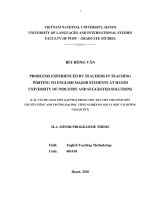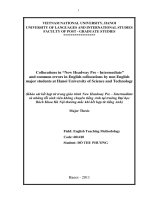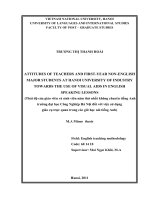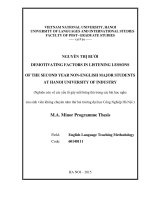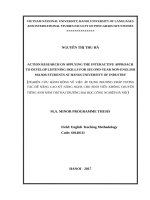Factors causing challenges in learning listening skills faced by first-year non-English major students at Hanoi University of Industry = Những khó khăn khi học
Bạn đang xem bản rút gọn của tài liệu. Xem và tải ngay bản đầy đủ của tài liệu tại đây (162.9 KB, 3 trang )
VIETNAM NATIONAL UNIVERSITY, HA NOI
UNIVERSITY OF LANGUAGES AND INTERNATIONAL STUDIES
FACULTY OF POST-GRADUATE STUDIES
NGUYỄN THỊ MINH HẠNH
FACTORS CAUSING CHALLENGES IN LEARNING
LISTENING SKILLS FACED BY FIRST-YEAR
NON-ENGLISH MAJOR STUDENTS AT
HANOI UNIVERSITY OF INDUSTRY
(NHỮNG YẾU TỐ GÂY RA KHÓ KHĂN KHI HỌC NGHE HIỂU CỦA
SINH VIÊN KHÔNG CHUYÊN TIẾNG ANH NĂM THỨ NHẤT
TRƯỜNG ĐẠI HỌC CÔNG NGHIỆP HÀ NỘI)
M.A. MINOR THESIS
Field: English Methodology
Code: 60.14.10
Hanoi, 2010
iv
TABLE OF CONTENTS
DECLARATION i
ACKNOWLEDGEMENTS ii
ABTRACT iii
TABLE OF CONTENTS iv
LIST OF ABBREVIATIONS vi
LIST OF TABLES vii
LIST OF FIGURES viii
PART I: INTRODUCTION 1
1. Rationale 1
2. Aims of the study 2
3. Research questions 2
4. Significance of the study 2
5. Scope of the study 3
6. Design of the study 3
PART II: DEVELOPMENT 4
CHAPTER 1: LITERATURE REVIEW 4
1.1 The role of Listening in language Learning and Teaching 4
1.2 Previous studies in listening problems faced by language learners 6
1.2.1 In general 6
1.2.2 In Vietnamese context 7
1.3 Common potential problems in EFL listening comprehension 8
1.4 Summary 9
CHAPTER 2: THE STUDY 10
2.1 The context of Hanoi University of Industry 10
2.1.1. Teachers 10
2.1.2. Students 10
2.1.3. Teaching and learning facilities 11
2.2. Research questions 11
2.3. Target population and sampling 11
2.4. Data Gathering Instruments 12
2.4.1. Student questionnaire 12
v
2.4.2. Teacher interview 13
2.4.3. Classroom observation 13
2.4.4. Document analysis 13
2.5. Data Analysis 14
CHAPTER 3: RESULTS 14
3.1 Results of the document analysis 15
3.1.1 The English program for non-English major students at HaUI 15
3.1.2 The website 16
3.1.3 The textbook of “New headway Elementary and Pre-intermediate” 16
3.1.4 The types and requirements of listening comprehension activities for non-
English major students at HaUI 17
3.2 Analysis of the
Quest
i
onna
i
re Data
18
3.2.1 The listening text 18
3.2.2 Listener factors 21
3.2.3 Speaker factors 25
3.2.4 Environmental factors 26
3.2.5 Other factors that affect the learners’ listening comprehension 28
3.2.6 The listening factor that poses the most difficulty for the learners 30
3.3 Analysis of Interview Data 31
3.4 Analysis of the data obtained from observation of the classroom listening
environment 34
3.5 Summary of the Results 34
PART III: CONCLUSIONS 36
1. Conclusions 36
2. Recommendations 37
3. Limitations and suggestions for further study 40
References 42
APPENDIXES
Appendix A: Questionnaire I
Appendix B: Instructor Interview III
Appendix C: Observation check list IV



